Energy labelling measures for household dishwashers (DW) came first into force in 1997, and were updated in 2010. Ecodesign measures were also introduced in 2010.
The 2019 regulations revise the basis for labelling and requirements again, requiring DWs to have an ‘eco program’. Efficiency- and functional requirements apply to this program. In addition there are requirements for low-power-mode, resource efficiency, and information supply.
Source: estimations from the Ecodesign Impact Accounting Overview Report 2024
Scope
The following table shows some examples of products in scope and out of scope in the Ecodesign Regulation:
| In Scope | Out of Scope |
|---|---|
|
|
Check the complete list in the Ecodesign Regulation and Energy Labelling Regulation.
Ecodesign Requirements
Rules on Ecodesign household dishwashers are mandatory for all manufacturers and importers wishing to sell their products in the EU.
From 1 March 2021, the Regulation on Ecodesign requirements for household dishwashers (EU) 2019/2022 repeals and replaces Regulation (EU) 1016/2010.
To improve the reparability of products, the new rules require that spare parts such as door hinges and seals, spray arms, filters and racks must be available to all for a period of 10 years after the product is taken off the market. Moreover, professional repairers will have access to the spare parts and information needs for the repair and professional maintenance of dishwashers for at least 7 years. The spare parts have to be delivered within 15 days.
Energy Label
The energy efficiency of dishwashers is constantly improving, aiming at using as little energy as possible to heat the water and wash dishes effectively. Using a dishwasher saves approximately half the water it would take to wash the same volume of crockery by hand. This also saves the energy required to heat all of that extra water. Did you know that to wash up by hand you use around 20L of water? In comparison, an efficient dishwasher uses just 9L to wash up to 15 place settings.
The EU Energy Label for household dishwashers uses, as of 1 March 2021, a scale from A (most efficient) to G (least efficient). The label provides information on the product’s
- energy efficiency class
- energy consumption for 100 cycles
- eco-programme duration
- water consumption for 1 cycle
- capacity of the dishwasher
- noise emissions
The European Product Registry for Energy Labelling (EPREL) offers more detailed information on models placed on the EU market. This can be accessed by scanning the QR code featured on the new energy labels. The database provides additional information such as the consumption in standby mode, panel technology, whether voice recognition, automatic brightness control and a room sensor are present, or the minimum duration of guarantee offered by the supplier.
The legal framework is Regulation on Energy Labelling for household dishwashers (EU) 2019/2017 that repeals and replaces Regulation (EU) 1059/2010.
| Understanding the Dishwasher Energy Label | |
|---|---|
| Note: The energy label details are based on the ECO programme. | |
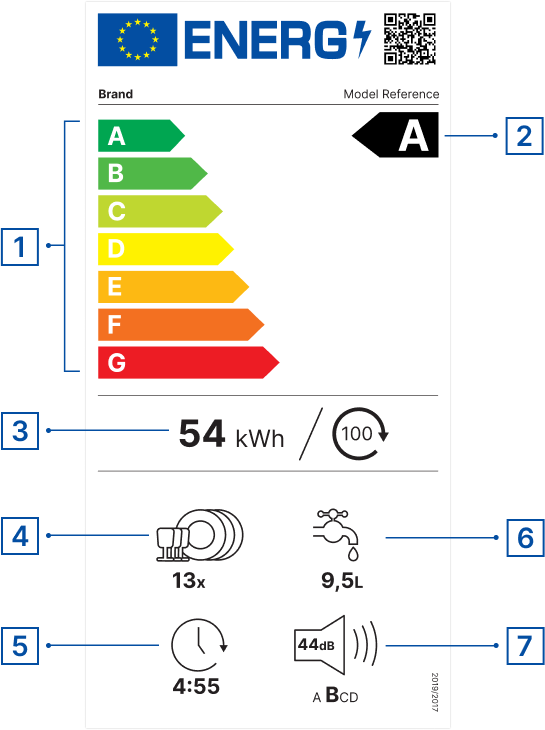 |
|
Facts & Figures
This graphic shows the estimated sales, stock, energy consumption (primary, electric or fuel), greenhouse gas emissions, consumer expenses and business revenues for years 2010 and 2030. The estimated values inside the graph bars are those from the EIA ECO-scenario, they include the effects of Ecodesign and Energy Labelling measures.
The difference with the business as usual (BAU) scenario without these measures is shown next to the graph bar. These figures indicate the estimated savings obtained due to the measures.
Product: Household Dishwashers Measures: Regulation (EU) 2019/2022, Regulation (EU) 2019/2017 |
|---|
| The striped lines in the charts show the 'Effect of the Regulations' |
SALES (x1000 units) 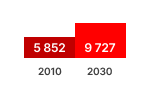 | STOCK (x1000 units) 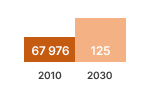 | Electricity (TWh/a) 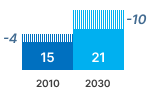 |
GHG-EMISSION 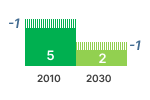 | CONSUMER EXPENSES 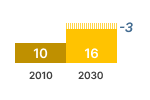 | REVENUES 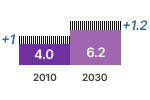 |
Source: estimations from the Ecodesign Impact Accounting Overview Report 2023
In 2020, 97 million dishwashers were in use in the EU27, roughly one dishwasher every two houses. Running 220 cycles per year, they washed 197 billion place settings, using 214 million m3 of water. This corresponds to 19 place settings and 21 litres water per week per EU household. The number of dishwashers is expected to increase, to 126 million in 2030.
In 1990, the average electricity consumption of sold dishwashers was 310 kWh/a (1.4 kWh per cycle). Without regulations, in 2020 this would have been 262 kWh/a, but due to Ecodesign and Energy Labelling it was reduced to 174 kWh/a (0.8 kWh per cycle, -34%). By 2030, a further decrease to 159 kWh/a is expected.
Water consumption was 6.7 m3/a (30 litres per cycle) in 1990. In 2020 this would have been 5.3 m3/a, but due to the regulations it was reduced to 2.2 m3/a (10 litres per cycle, -58%). By 2030, a further decrease to 1.9 m3/a is expected.
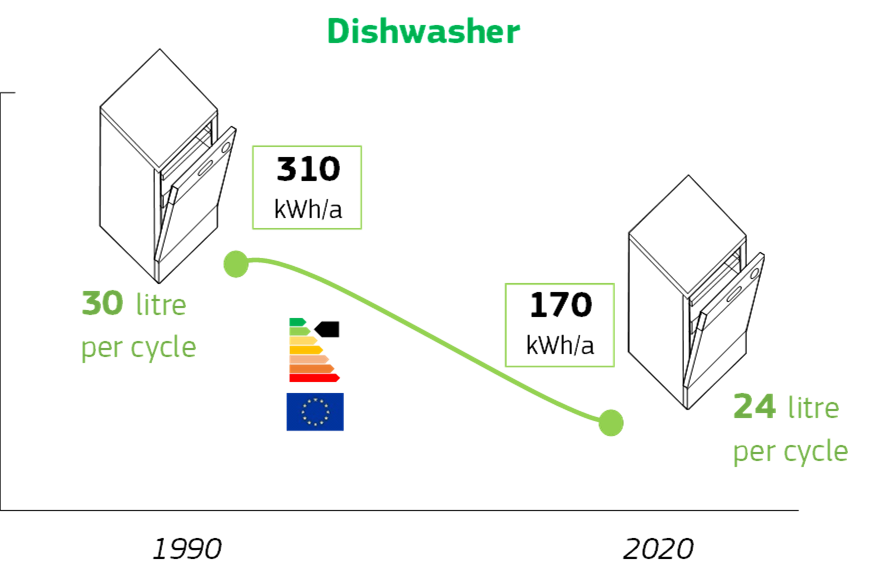
The regulations saved 7.3 TWh of electricity and 295 million m3 of water in 2020, projected to increase to 10 TWh and 421 million m3 by 2030. For the average household this means a saving of 47 kWh of electricity and 2000 litres of water per year in 2030, due to Ecodesign and Energy Labelling measures.
The 2030 savings are 0.42% of EU27 electricity consumption in 2020, comparable to the consumption of Lithuania.
Due to Ecodesign and Labelling measures, EU27 users saved € 1.3 billion on dishwashers (incl. water expenses) in 2020, projected to increase to € 3.0 billion in 2030. This is a 16% saving due to the measures taken.
In 2030, the annual household dishwasher expenses (incl. water expenses) decrease from € 90 to € 77.
Expected Savings
Expenses
More efficient DWs have higher acquisition cost. In 2020 EU-consumers spent €1.5 bn extra buying such DWs, but this was compensated for with €1.5 bn lower electricity costs and €1.3 bn lower water and detergent costs, for a net expenditure savings of €1.3 bn. In 2030, these savings are expected to be €3.0 billion, of which 1.9 bn on water and detergents.
Total EU27 User Expenses for Dishwashers
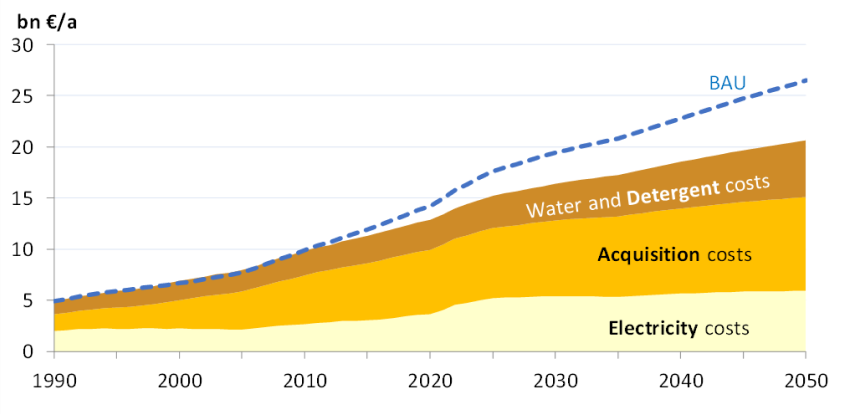
Efficiency and Energy
In 1995, before the first measures, the average newly sold DW consumed 291 kWh/a of electricity. Without measures, this was projected to be 254 kWh/a in 2020 and 239 kWh/a in 2030. Due to the combined measures, this has been reduced to 174 kWh/a in 2020 (-80 kWh, -31%) and expected 159 kWh/a by 2030 (-80 kWh/a, -33%).
At EU27-level, considering also the strongly increasing quantity of installed DW, this enabled a reduction of the total DW electricity consumption from 25 to 18 TWh/a in 2020 (-28%), and from expected 31 to 21 TWh/a in 2030 (-32%).
Total EU27 Electricity Consumption and Stock Development of Dishwashers
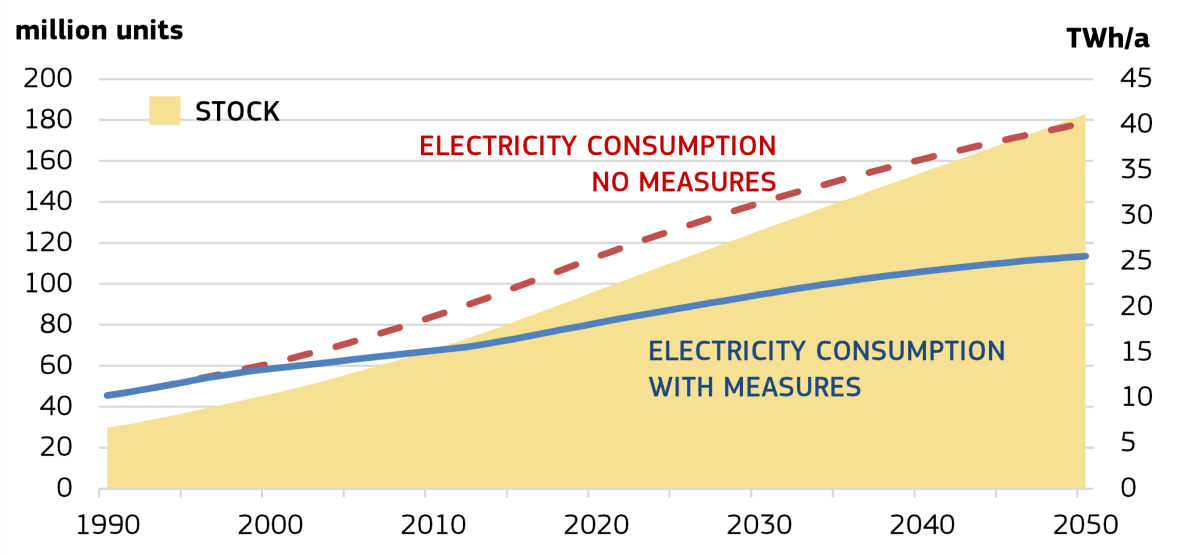
Source: estimations from the Ecodesign Impact Accounting Overview Report 2024

Suppliers
Suppliers shall ensure that:
(a) each household dishwasher is supplied with a printed label in the format as set out in Annex III;
(b) the parameters of the product information sheet, as set out in Annex V, are entered into the product database;
(c) if specifically requested by the dealer, the product information sheet shall be made available in printed form;
(d) the content of the technical documentation, set out in Annex VI, is entered into the product database;
(e) any visual advertisement for a specific model of household dishwasher contains the energy efficiency class and the range of energy efficiency classes available on the label in accordance with Annex VII and Annex VIII;
(f) any technical promotional material concerning a specific model of household dishwasher, including on the Internet, which describes its specific technical parameters, includes the energy efficiency class of that model and the range of energy efficiency classes available on the label, in accordance with Annex VII;
(g) an electronic label in the format and containing the information, as set out in Annex III, is made available to dealers for each household dishwasher model;
(h) an electronic product information sheet, as set out in Annex V, is made available to dealers for each household dishwasher model.

Dealers
Dealers shall ensure that:
(a) each household dishwasher, at the point of sale, including at trade fairs, bears the label provided by suppliers in accordance with point 1(a) of Article 3, with the label being displayed for built-in household dishwashers in such a way as to be clearly visible, and for all other household dishwashers in such a way as to be clearly visible on the outside of the front or top of the household dishwasher;
(b) in the event of distance selling, the label and product information sheet are provided in accordance with Annexes VII and VIII;
(c) any visual advertisement for a specific model of household dishwasher contains the energy efficiency class of that model and the range of energy efficiency classes available on the label, in accordance with Annex VII;
(d) any technical promotional material concerning a specific model of household dishwasher, including on the Internet, which describes its specific technical parameters, includes the energy efficiency class of that model and the range of energy efficiency classes available on the label, in accordance with Annex VII.

Policy
Ongoing legislative work
Please check the ongoing initiatives on the Have your say portal.
Regulation (EU) 2019/2022 of 1 October 2019 laying down Ecodesign requirements for household dishwashers pursuant to Directive 2009/125/EC of the European Parliament and of the Council amending Commission Regulation (EC) No 1275/2008 and repealing Commission Regulation (EU) No 1016/2010 (OJ L 315, 5.12.2019, pp. 267-284)
Regulation (EU) 2019/2017 of 11 March 2019 supplementing Regulation (EU) 2017/1369 of the European Parliament and of the Council with regard to energy labelling of household dishwashers and repealing Commission Delegated Regulation (EU) No 1059/2010 (OJ L 315, 5.12.2019, pp. 134-154)
What is the aim of the regulations?
Household dishwashers are subject to new and revised Ecodesign* requirements and Energy Labelling* rules. Ecodesign and Energy Labelling go hand-in-hand providing European consumers with valuable information to enable them to make an informed choice and eventually increase the market for more energy efficient products.
Regulation (EU) 2019/2022 sets out Ecodesign requirements, pursuant to Directive 2009/125/EC, for the sale of or putting into service electric mains-operated household dishwashers, including built-in household dishwashers and electric mains-operated household dishwashers that can also be powered by batteries. It amends Regulation (EC) No 1275/2008 and repeals Regulation (EU) No 1016/2010.
Delegated Regulation (EU) 2019/2017 sets out rules on the labelling of, and supply of additional product information on, these appliances. It supplements Regulation (EU) 2017/1369 and repeals Delegated Regulation (EU) No 1059/2010.
Key points
The Regulation (EU) 2019/2022:
- Sets out the Ecodesign requirements in Annex II, which cover:
- programme requirements, including rules on providing an eco programme. The eco programme must be set as the default programme where possible, or made available for direct selection without the need for any other selection such as a specific temperature or load. The indications ‘normal’, ‘daily’, ‘regular’ and ‘standard’ must not be used in programme names either alone or in combination with other information;
- energy efficiency;
- functional requirements, including cleaning and drying performance;
- low power modes (off mode and standby mode);
- resource efficiency, including availability of spare parts, access to repair and maintenance information, material recovery and recycling;
- information for installers and end-users.
- Sets out the conformity assessment procedure: national authorities must apply the verification procedures laid down in Annex IV when carrying out market surveillance checks, and the measurement methods and calculations that must be followed in Annex III.
- Annex V sets out indicative benchmarks based on the best available technology on the market for energy efficiency, energy and water consumption, airborne acoustical noise emissions and programme duration for the eco programme.
Delegated Regulation (EU) 2019/2017 supplements Regulation (EU) 2017/1369 on Energy Labelling and sets out:
The energy efficiency class and the acoustic airborne noise emission class which are based on an index set out in Annex II.
From when do the regulations apply?
They both apply from 1 March 2021.
Background
- Directive 2009/125/EC establishes a framework to set Ecodesign requirements for energy-related products. It tasks the Commission to set these for products which are widely sold and traded in the EU and have a significant environmental impact.
- Regulation (EU) 2017/1369 establishes a framework to set Energy Labelling requirements for energy-related products to enable consumers to choose more efficient products to reduce their energy consumption.
- The WEEE Directive set requirements on e.g. recovery and recycling of waste electrical and electronic equipment (WEEE) to reduce the negative environmental effects resulting from the generation and management of WEEE and from resource use.
For more information, see:
- Dishwashers (European Commission)
- The new Ecodesign measures explained (European Commission)
- EU Ecodesign for Dishwashers (European Commission Joint Research Centre)
- New energy efficiency labels explained (European Commission)
- About the energy label and Ecodesign (European Commission).
Disclaimer: please pay attention to possible updates/changes as indicated in the Official Journal (green dot)
Useful Links
Regulation (EU) 2017/1369 of the European Parliament and of the Council of 4 July 2017 setting a Framework for Energy Labelling and repealing Directive 2010/30/EU (OJ L 198, 28.7.2017, pp. 1-23)
Directive 2009/125/EC of the European Parliament and of the Council of 21 October 2009 establishing a framework for the setting of Ecodesign requirements for energy-related products (OJ L 285, 31.10.2009, pp. 10-35)
Commission Implementing Decision (EU) 2023/1759 of 11 September 2023 on the harmonised standards for household dishwashers drafted in support of Regulation (EU) 2019/2022 and Delegated Regulation (EU) 2019/2017
Regulation (EU) 2021/340 amending Regulations (EU) 2019/2013 to 2018
Regulation (EU) 2021/341 amending Regulations (EU) 2019/424, 1781 and 2020 to 2024
Commission Communication: Harmonised standards for household dishwashers

